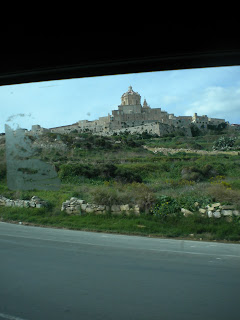Founded by the Knights of the Order of St. John after the islands were given to the Knights by the Spanish crown in the 16th century, the Order fortified the harbor to defend against marauding pirates and provided protection for Christian pilgrims traveling to and from the Holy Land. The members of the Knights were drawn from the most distinguished aristocratic families in Europe.
The country's strategic location in the Mediterranean has resulted in a series of invasions by the Phoenicians, Romans, Arabs, Berbers, Turks and most recently, the British.
Below, our first view of Valletta. (Taken from the ship).
Geologically, the island is composed of limestone; therefore, all buildings on Malta are constructed of the sand colored stone, creating a unique blending of man-made structures and the surrounding landscape.
At the dock in Valletta, Malta, Celebrity's Silhouette and some of our friends.
Through our friend, Carol Velocci, a taxi had been engaged to transport us through the city of Valletta and to the various locations that we had planned to visit for the day.
And, to our first stop, Casa Rocca Piccola, a 16th century palace of over 50 rooms, originally the property of Don Pietro, La Rocca, a Knight of Malta and Admiral. Casa Rocca is now the ancestral home of the 9th Marquis & Marchioness de Piro.
A parrot in the garden of Casa Rocca Piccola.
Inside the Casa Rocca.
And back in the lovely garden.
Our next stop was the Rotunda of Mosta. The Church of the Assumption of Our Lady, commonly known as the Rotunda of Mosta is a Roman Catholic church in Mosta, Malta.
Built in the 19th century on the site of a previous church, it was designed by a Maltese architect. Its unsupported dome is the third-largest church dome in Europe and the ninth largest in the world with an internal diameter of 122 feet. The rotunda walls are nearly 30 feet thick. The architect's plans were based on the Pantheon in Rome. Construction began in 1833 and was completed in the 1860s.
Below, inside the beautiful dome.
Outside, we waited in the courtyard for our driver.
Back in the vehicle we proceeded to the countryside where we could view our destination, the ancient city of Mdina
At the city of Mdina the driver dropped us and we entered across the bridge that spanned the moat and viewed the ancient wall.
Inside, a beautiful statute.
Like most ancient cities, the streets are narrow.
and the buildings beautiful. Most of Mdina's palaces serve as private homes.
This door decoration was interesting.
We walked toward a beautiful church.
We chose to walk as did most of the people visiting Mdina that day.
We climbed a couple of floors above the street to Fontanella Tea Room, a restaurant famous for its delicious cake. There we had lunch and shared a huge, delicious piece of cake.
Continuing back to the place where we were to meet our driver, we walked past this beautiful statute.
The bougainvillea was so beautiful!
As was the countryside.
Months prior to this trip each couple in our group of 10 had all obtained tickets to visit the Hypogeum in Paola, Malta. After lunch, our driver then took us there where we waited for our 1:00 p.m. scheduled visit. The Hypogeum is a subterranean structure dating to 3000-2500 BC. Thought to be originally a sanctuary, it became a necropolis in prehistoric times. It is the only prehistoric underground temple in the world. The site was closed to visitors between 1992 and 1996 for restoration works; since it reopened only 80 people per day are allowed entry.
The Hypogeum was discovered by accident in 1902 when workers cutting cisterns for a new housing development broke through its roof. The workers tried to hide the temple at first, but eventually it was found.
Prior to our entry into the Hypogeum our cameras were taken from us and locked away. Thus, we made no pictures of the site.
Our driver took us back to the center of the town of Valletta where we, in a group of 6-8 walked through the shops, including a few bakeries. In one such place we bought wonderful cannolis (vanilla on one side, chocolate on the other) that were really delicious. After a walk through a very beautiful upscale shopping area near the port we returned to our ship.











































No comments:
Post a Comment